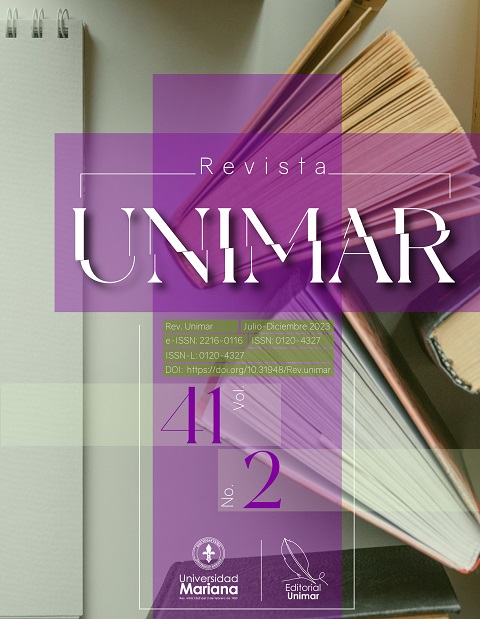Criação de conteúdo audiovisual pelos alunos para reforçar seu aprendizado
DOI:
https://doi.org/10.31948/Rev.unimar/unimar41-2-art8Palavras-chave:
aprendizagem, conteúdo audiovisual, inovação educacional, aula invertida, professores, estudantesResumo
O ensino superior está em constante mudança. As maneiras pelas quais os alunos adquirem conhecimento estão se tornando cada vez mais diversificadas devido ao uso constante das tecnologias de informação e comunicação. Por outro lado, as técnicas pedagógicas usadas pelos professores no processo de ensino também estão mudando; uma delas se baseia no desenvolvimento da autoaprendizagem e da autogestão dos alunos. Este estudo é derivado da nova didática educacional que está presente dentro e fora da sala de aula e de como os alunos podem se envolver no processo de ensino. O objetivo deste artigo é mostrar o papel ativo que eles desempenham em seu aprendizado por meio do desenvolvimento de conteúdo audiovisual que os ajuda a reforçar seus conhecimentos, com base na orientação do corpo docente. A análise teve uma metodologia quantitativa; um questionário de dez itens foi aplicado a cem alunos de diferentes programas acadêmicos em nível de graduação. Os resultados mostram que os sujeitos do estudo aprofundam seus conhecimentos por meio dos materiais de vídeo que desenvolvem; além disso, eles criam conexões mais flexíveis com o uso de plataformas e dispositivos que usam todos os dias; de facto, eles têm um uso lúdico e não apenas para entretenimento. Concluindo, incentivar os alunos a criar seu próprio conteúdo audiovisual fortalece a técnica de aprendizado conhecida como sala de aula invertida e, certamente, fortalece a inovação educacional.
Biografia do Autor
Rodrigo Urcid Puga, Instituto Tecnológico y de Estudios Superiores de Monterrey
Dr. Planeación Estratégica y Dirección de Tecnologías (Universidad Popular Autónoma del Estado de Puebla). Profesor de tiempo completo en el Departamento de Medios y Cultura Digital en el Tecnológico de Monterrey, Escuela de Humanidades y Educación.
Referências
Arrieta, A.C. y Montes, D.V. (2011). Alfabetización digital: uso de las TIC más allá de una formación instrumental y una buena infraestructura. Revista Colombiana de Ciencia Animal, 3(1) 180-197. https://doi.org/10.24188/recia.v3.n1.2011.360
Augsburg, T. (2015). Becoming Interdisciplinary: An Introduction to Interdisciplinary Studies.
Collis, B. y Moonen, J. (2006). Information technology in higher education: emergent paradigms. RUSC. Universities and Knowledge Society Journal, 1(2), 1-18. https://doi.org/10.7238/rusc.v2i2.254
Esteban, A., Tejedor, S., Pérez, J., Portalés, M., Calle, J., Durán, T. y Pi, M. (2015). El uso del audiovisual en las aulas. Grupo Planeta.
Fortanet, C., Díaz, C. G., Pastor, E. M. y Ramón, J. L. (2013). Aprendizaje cooperativo y flipped classroom. Ensayos y resultados de la metodología docente. En M. Tortosa, J. Álvarez y N. Pellín (coord.), XI Jornadas de Redes de Investigación en Docencia Universitaria (pp. 1151-1162). Universidad de Alicante.
García, M. L., Porto, M. y Hernández, F. J. (2019). El aula invertida con alumnos de primero de magisterio: fortalezas y debilidades. REDU Revista de Docencia Universitaria, 17(2), 89-106. https://doi.org/10.4995/redu.2019.11076
González, C., Estévez, C. G., Cabrera, D. y Chinea, P. (2012). Contenidos audiovisuales en la docencia universitaria: de su producción a la validación de su eficacia como material educativo. En J. Santos (ed.), TUCAI 2012: Tic para el aprendizaje de la Ingeniería, (pp. 39-46). IEEE Sociedad de Educación.
González, M. O. y Huerta, P. (2019). Experiencia del aula invertida para promover estudiantes prosumidores del nivel superior. RIED, Revista Iberoamericana de Educación a Distancia, 22(2), 245-263. https://doi.org/10.5944/ried.22.2.23065
Hyvönen, P., & Järvelä, S. (2016). Interaction forms in successful collaborative learning in virtual learning environments. Active Learning in Higher Education, 17, 25-38. https://doi.org/10.1177/1469787415616730
Max-Neef, M. (2005). Foundations of transdisciplinary. Ecological Economics, 53(1), 5-16. https://doi.org/10.1016/j.ecolecon.2005.01.014
Medina, L. y Guzmán, L. (2011). Innovación curricular en instituciones de educación superior. Pautas y procesos para su diseño y gestión. ANUIES.
Noguera, I. (2013). Technology-enhanced education for Millennials: how the Information Society is changing the way of learning. https://diposit.ub.edu/dspace/bitstream/2445/49169/1/Noguera%2C%20I._Technology-enhanced%20education%20for%20Millennials.pdf
Pedroza, R. y García, B. (comp.) (2015). Flexibilidad académica y curricular en las instituciones de educación superior. Miguel Ángel Porrúa.
Rivera, F. y García, A. (2018). Aula invertida con tecnologías emergentes en ambientes virtuales en la Universidad Politécnica Salesiana del Ecuador. Revista Cubana de Educación Superior, 37(1),108-123. http://scielo.sld.cu/pdf/rces/v37n1/rces08118.pdf
Rojas, M. (2011). Guía para la producción de material audiovisual de carácter educativo. centro de medios audio-visuales. CEMAV. https://canal.uned.es/uploads/serialmaterial/Serie/1192/Gu__a_para_la_producci__n_de_material_audiovisual_educativo..pdf
Ruiz, F. y Parrilli, M. L. (2015). Sobre flexibilidad educativa. Revista de Informática Educativa y Medios Audiovisuales, 12(19), 1-4.
Sánchez, E. (2012). Creaciones de contenidos audiovisuales producidos por los estudiantes como nuevo instrumento en el proceso de la enseñanza y aprendizaje: metodología y resultados. Actas de las XVIII Jornadas sobre la Enseñanza Universitaria de la Informática, 10(13), 223-230. https://aenui.org/actas/pdf/JENUI_2012_040.pdf
Sánchez, G., Pérez, J. J. y Picco, L. L. (2014). Redes de Conocimiento basadas en la gestión del conocimiento: creación y organización para docencia e investigación universitaria. Revista Interamericana de Bibliotecología, 37(3), 215-225. http://www.scielo.org.co/pdf/rib/v37n3/v37n3a2.pdf
Sotolongo, P. L. y Delgado, S. J. (2016). La complejidad y el diálogo transdisciplinario de saberes. Trans-pasando Fronteras, (10), 11-24. https://doi.org/10.18046/retf.i10.2631
Van del Linde, G. (2007). ¿Por qué es importante la interdisciplinariedad en la educación superior? Cuadernos de Pedagogía Universitaria, 4(8), 11-13. https://doi.org/10.29197/cpu.v4i8.68
Van-Veen, B. (2013). Flipping signal-processing instruction. IEEE Signal Processing Magazine, 30(6), 145-150. https://doi.org/10.1109/MSP.2013.2276650
Ventura, J. y Humberstone, J. (2018). Enfoque multdisciplinario para mejorar los ambientes de aprendizaje. Revista Ciencia, Cultura y Sociedad, 5(1) 30-39. https://doi.org/10.5377/ccs.v5i1.8197
Como Citar
Downloads
Downloads
Publicado
Edição
Seção
Licença
Copyright (c) 2023 Revista UNIMAR

Este trabalho está licenciado sob uma licença Creative Commons Attribution 4.0 International License.
Los autores que publiquen en esta revista aceptan las siguientes condiciones:
1. Los autores conservan los derechos de autor y ceden a la revista el derecho de la primera publicación, con el trabajo registrado con la licencia de atribución de Creative Commons, que permite a terceros utilizar lo publicado siempre que mencionen la autoría del trabajo y a la primera publicación en esta revista.
2. Los autores pueden realizar otros acuerdos contractuales independientes y adicionales para la distribución no exclusiva de la versión del artículo publicado en esta revista (p. ej., incluirlo en un repositorio institucional o publicarlo en un libro) siempre que indiquen claramente que el trabajo se publicó por primera vez en esta revista.
3. Se permite y recomienda a los autores publicar su trabajo en Internet (por ejemplo en páginas institucionales o personales) antes y durante el proceso de revisión y publicación, ya que puede conducir a intercambios productivos y a una mayor y más rápida difusión del trabajo publicado (veaThe Effect of Open Access).
| Métricas do artigo | |
|---|---|
| Vistas abstratas | |
| Visualizações da cozinha | |
| Visualizações de PDF | |
| Visualizações em HTML | |
| Outras visualizações | |








